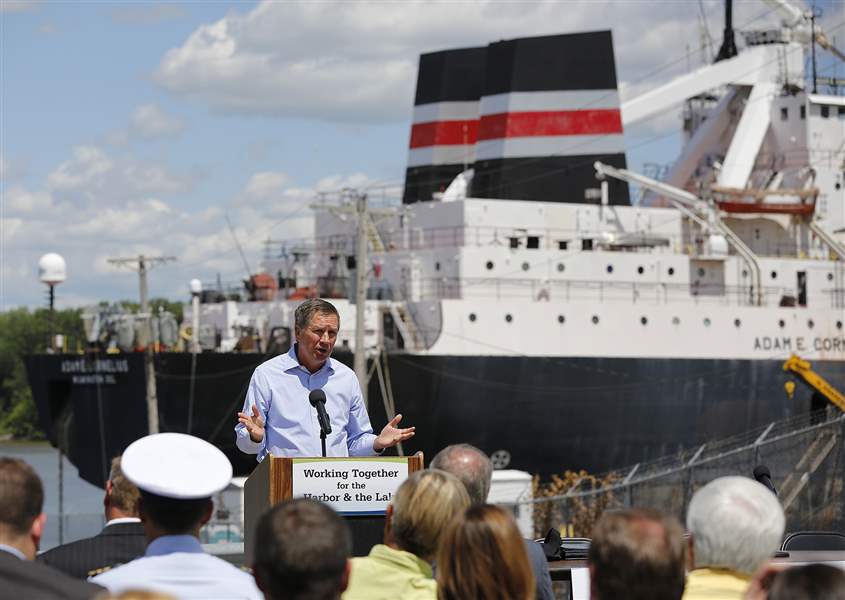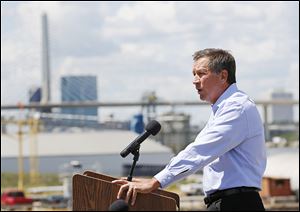
Kasich commits to dredging strategy
Governor adds supporting signature to $6M Maumee River research plan
7/18/2014
Kasich signed a bill for a $6 million research project along the Maumee River.
THE BLADE/DAVE ZAPOTOSKY
Buy This Image

Kasich offers his support of a dredging strategy for the Toledo Harbor during an event at the Toledo Shipyard on Front Street.
Standing along the Maumee River shoreline near downtown, Gov. John Kasich said Thursday the plan to put some of the dredgings from Toledo’s shipping channel on Riverside Park in North Toledo is a big step toward the revitalization of Toledo.
For years, the U.S. Army Corps of Engineers has dumped river dredgings into the open water of Lake Erie’s North Maumee Bay, a practice scientists believe contributes to the lake’s algae problem and impairs its valuable fishing habitat. While talking up the ecological benefits of the lake, the governor also implored Toledo Mayor D. Michael Collins to do what he can to promote more development along the Maumee River waterfront.
Each summer, the Corps removes silt from the shipping channel equal to the amount of dirt it would take to fill downtown Toledo’s tallest high-rise building three times. To envision this, bear in mind that the 32-floor Fifth Third Center at One SeaGate is 411 feet tall.
To do that, you’d need about 800,000 cubic yards of dirt.
The Corps digs that much silt out of the Toledo shipping channel annually to keep it open for a Great Lakes shipping industry that supports 7,000 jobs and contributes $1 billion a year to northwest Ohio’s economy.
This year, the Corps said it needs to dig more. It is planning to dredge a million cubic yards.
State and federal officials have said that an enormous volume gets to the heart of the open-lake disposal controversy: It’s costly to move sediment out of the water. The least expensive, though not the most environmentally friendly, thing to do has been to dump most of it a few miles away in North Maumee Bay.
It’s an issue that Ohio and Michigan governors from both the Republican and Democratic parties have battled the Corps on for 30 years.
When Governor Kasich committed his signature Thursday to a $6 million research project along the Maumee River that seeks viable, cost-effective ways of reusing the silt, onlookers such as Capt. Paul Pacholski of the Lake Erie Charter Boat Association were calling it “one of the most monumental days I’ve seen.”
While Ohio Environmental Protection Agency Director Craig Butler told The Blade the state will be lucky to get 10 percent of the total taken to the project site — North Toledo’s Riverside Park — many of the nearly 100 people who attended the signing hailed it as a step in the right direction.
“It should have been done 25 years ago,” Mr. Kasich told reporters after his remarks.
Fifteen of Riverside Park’s 52 acres have been set aside to test theories about how well the mixture of fine sand, clay, and soil pulled from the shipping channel can be reused to grow crops or be used for other purposes, such as to make compost, to raise the elevation of farm fields, or as fill for demolished houses, landscaping, or landfill cover.
The park, created 120 years ago, has been inaccessible to the public for decades. Located on North Summit Street behind Jamie Farr Park, Riverside Park will get a bulkhead or dock to accommodate dredging barges.
The project calls for better road access, fences, and drainage. Also in the works is an information hub to be known as the Great Lakes Dredged Material Center of Innovation.
The study drew praise from one of Mr. Kasich’s sharpest critics, the Ohio Environmental Council.
“This is a fantastic breakthrough,” Jack Shaner, the council’s deputy director, said. “This is a classic win-win for the environment and the economy.”
The $6 million is coming from the state’s $10 million Healthy Lake Erie Initiative, which Ohio Sen. Randy Gardner (R., Bowling Green) recently got passed through the state legislature and signed into law by Mr. Kasich.
The remaining $4 million will be used for pilot projects to address dredging concerns in other parts of the state, including Cleveland, Mr. Butler said.
But Mayor Collins and others agreed it finally has taken the region beyond the talk stage.
Toledo is the most heavily dredged shipping channel in the Great Lakes region because it is so shallow.
“Let’s not over-promise here,” Mr. Kasich said as he began his remarks. “[But] if this can work, the program can be expanded.”
The governor also challenged Mr. Collins to do what he can to develop the Maumee River shoreline, to bring people closer to it.
“Go to Pittsburgh,” Mr. Kasich said. “Everybody wants to be along the river in Pittsburgh.”
“It’s a matter of priorities,” he said. “I can’t think of a higher priority than a healthy Lake Erie.”
Democratic gubernatorial opponent Ed Fitzgerald’s campaign staff issued a statement that said Mr. Kasich “failed to mention the $51.5 million lost to Lucas County through local government cuts and the untold impact on Toledo’s energy economy through SB 310.”
That was a reference to controversial legislation Mr. Kasich signed into law that made Ohio the first state in the nation to freeze requirements for utilities to invest more in renewable energy. The legislation was pushed by FirstEnergy Corp., as well as the Ohio Chamber of Commerce and other utilities, against the objections of environmentalists and major manufacturers involved in renewable energy, including Toledo-area Rudolph/Libbe Inc.
“We need a governor who is invested in making Ohio work for Toledo’s working people, not one who doesn’t show up until it’s election season,” according to a statement attributed to Toledo Councilman Lindsay Webb.
Contact Tom Henry at: thenry@theblade.com or 419-724-6079.